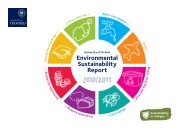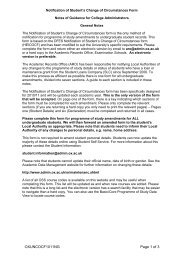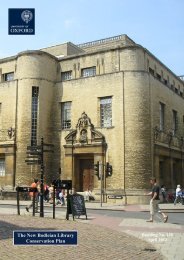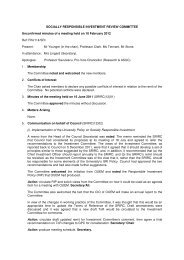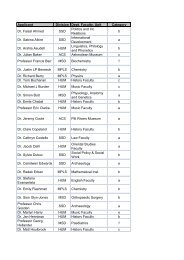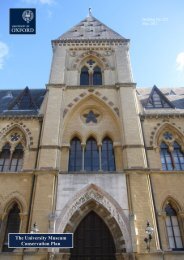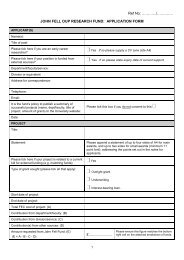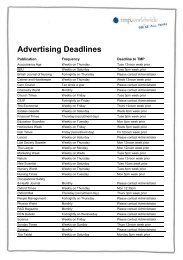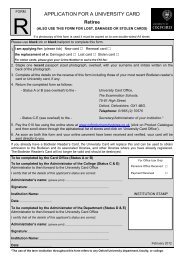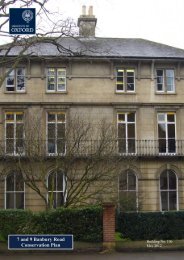Dyson Perrins Laboratory - Central Administration - University of ...
Dyson Perrins Laboratory - Central Administration - University of ...
Dyson Perrins Laboratory - Central Administration - University of ...
- No tags were found...
Create successful ePaper yourself
Turn your PDF publications into a flip-book with our unique Google optimized e-Paper software.
scale <strong>of</strong> government-backed research, were restricted from publishing any <strong>of</strong> it due to itssensitive nature and the wartime conditions. 18 Robinson’s reputation attracted researchstudents and by 1940 there were sixty in the laboratory. <strong>Dyson</strong> <strong>Perrins</strong> was busy and sufferedfrom a lack <strong>of</strong> space, a problem exacerbated by the closure <strong>of</strong> the Queen’s College laboratoryin 1936. 19 In 1939-40, a large brick-built extension was constructed to the north (green inFigure 5). It was funded by £26,000 from the Rockefeller Foundation and £6,000 from ICI.The extension was apparently planned by Robinson, with no consultation with the other staff,and was unpopular from the start. As a user <strong>of</strong> the building, Smith gives a damning outline <strong>of</strong>Robinson’s extension‘Obvious even to the inexpert were many faults: the flat ro<strong>of</strong> (<strong>of</strong> course) leaked badly, even inits first year; the thin, hollow doors made explosive noises when they slammed; the doorhandlesturned unpredictedly [sic.] in one direction only (this is a near-crime in anylaboratory); the flimsy gas-taps closed unless wedged open; all the lights cast the researchworker’sshadow on to his bench; the ghastly, inadequately opening, expensive draughtchambershad their exhaust pipes close together on the ro<strong>of</strong>, so that the fumes from one blewdown the others unless all fans were on; the passages and stairs were wasteful; the“services” were below the minimum, even for war-time 1940; there was no bridge from thefirst floor to the main building, making the service room a long walk away; even the roomdesigned for micro-analysis had hot-water radiators under the stone benches for the microbalances!I had asked…for a fire-pro<strong>of</strong> room, a cold-room, a room for hyrogenators next [to]the workshop, a glass-blower’s room- none <strong>of</strong> these was provided.’ 20The laboratory had been busy during the War but it found an even greater influx <strong>of</strong> studentsafter 1945. Several requests were made for more laboratories in the 1950s but these wererefused and the department found itself falling into a state <strong>of</strong> decay. Robinson, who wasawarded the Nobel Prize in 1947, retired from the Waynflete Chair in 1955 at the age <strong>of</strong> 69,and with rare energy began a new career at Shell. E.R.H. Jones was <strong>of</strong>fered the pr<strong>of</strong>essorship,and found himself in much the same position as Perkin had 40 years previously: he wasrunning a highly-successful and state-<strong>of</strong>-the-art laboratory in Manchester and was notimpressed by the decaying surroundings <strong>of</strong> Oxford’s laboratories. 21 Like Perkin, Jonesaccepted the Waynflete Chair only on the condition that appropriate surroundings wereprovided, including an extension and renovation <strong>of</strong> the <strong>Dyson</strong> <strong>Perrins</strong> <strong>Laboratory</strong>. Severalrequests had been made for new buildings throughout the early 1950s, but it was Jones’sappointment which secured their construction.18 Ibid, II.12.19 Williams, R.J.P., Chapman, A., and Rawlinson, J.S., Chemistry at Oxford: A History from 1600 to 2005(Cambridge, 2009) 161.20 Smith, op. cit.,, II.14.21 Knowles, J., ‘The <strong>Dyson</strong> <strong>Perrins</strong> <strong>Laboratory</strong> at Oxford’ in Organic and Biomolecular Chemistry Vol. 1, 21(2003) 3625-3627.The <strong>Dyson</strong> <strong>Perrins</strong> <strong>Laboratory</strong>, Oxford 19Conservation Plan, May 2012



